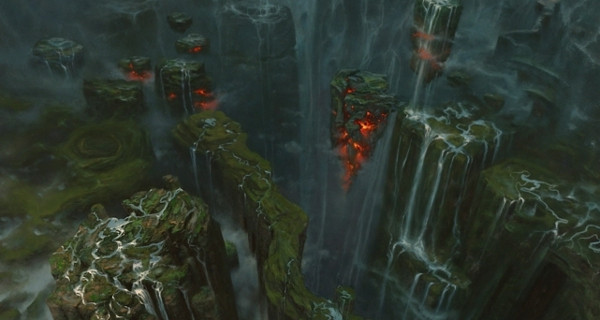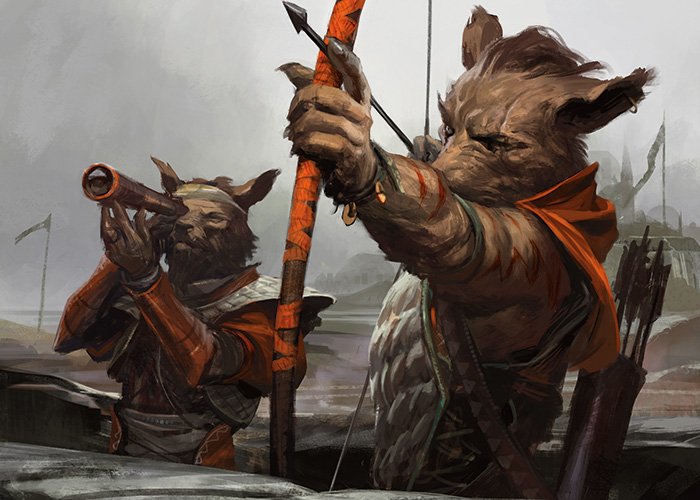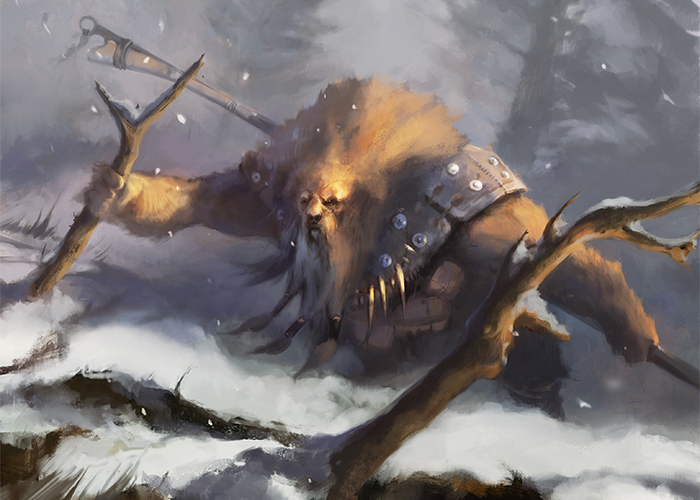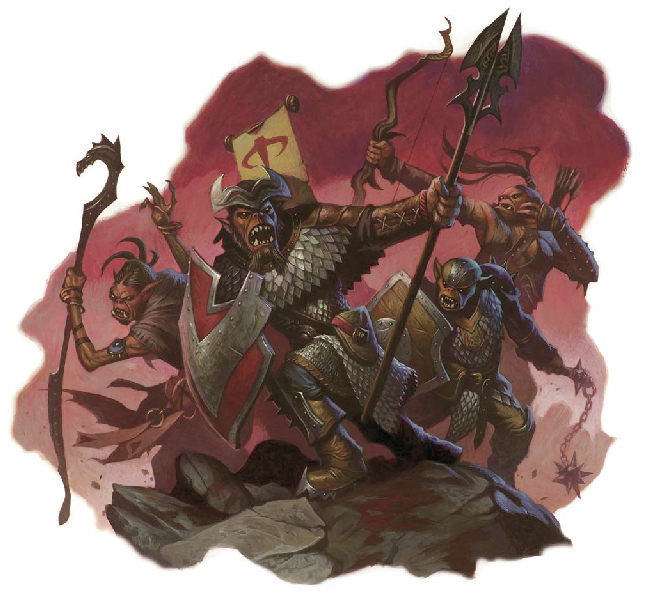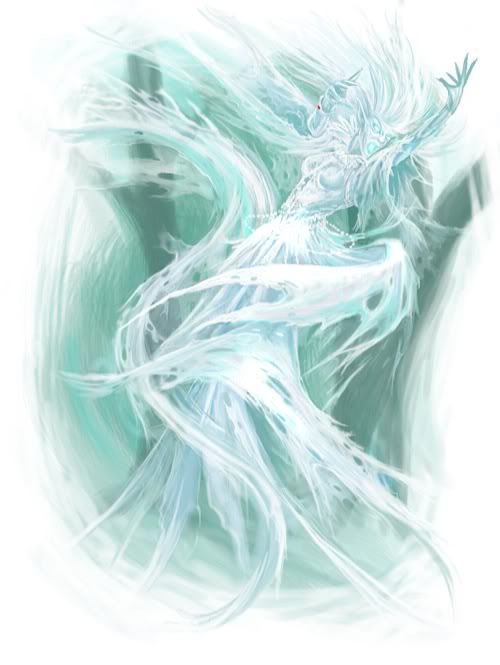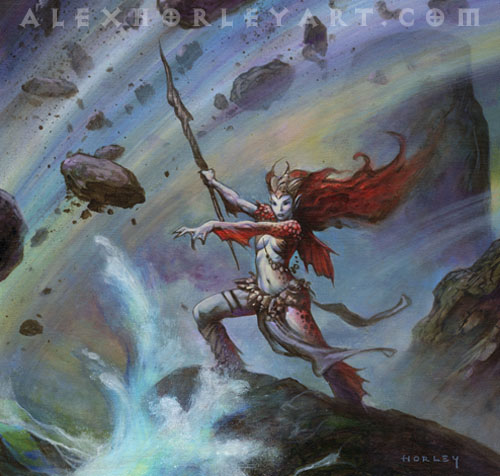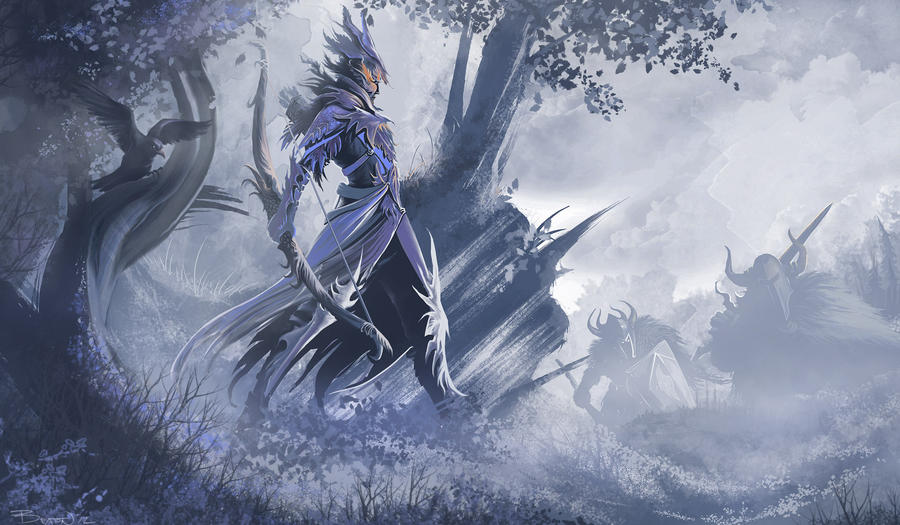D&D 5e is out only through the (incredibly promising) Starter Set as of now, but I couldn't hold myself anymore, I did it again: I created a custom class!
Actually, I haven't created it yet... I have some notes, a stream-of-consciousness-like thread of facebook comments in the D&D Next group, and many ideas in my head. But possibly, here and now the class is going to take the first gaming-terms form for the first time.
First of all, a little intro as I'm used to do.
Why a new class, and why the Weaver
To the first question, usually I wouldn't bother replying, because in my world (real-world sense), with my parameters, there is nearly always space for a new class. However, many people are concerned with this question, probably because they don't have/know fixed parameters to regulate new classes.
To me a new class has to exist when NO other class or even multiclass combination has the mechanical and thematic space to allocate for a given concept.
Negative examples:
- A Pirate class? Nonsense: even if the thematical niche is big enough, there is nothing in their way of doing things that couldn't be done with other classes, so it ends up being a Background in D&D 5e terms.
- A Ninja class? Hardly: as a subclass of the Rogue or Monk (boys, it's really coming as the latter!!) every needed mechanic can be represented, so add a specific custom Background to that, and a new Class becomes completely redundant.
- An alternative caster class? Depends: if we're just talking of a new way of dealing with existing spells, you could make a new class mechanics-wise, but thematically it's surely going to step on others, becoming more useful as a simple replacement of slots for an existing class, like it happened during the playtest of D&D 5e for the spell points system.
So, for many people, this would mean there is really no space for new classes. For me, it means you just restricted an endless pool to a still numerous list.
The Weaver is a spellcaster in thematic terms (and even there, with a foot steadily set on "trickster class" territory), but mechanically is a completely new animal, with absolutely no spells in traditional sense.
It draws from many past concepts to ultimately becoming something completely unique and new, and as such, also difficult to explain.
I will start with a quote from my draft of full class write-up, to make the Weaver more of a solid concept: sample characters scenes like in the upcoming D&D 5e Player's Handbook!
A mischievous gnome hops around a minotaur, artfully dodging his axe, and suddenly the expression on the minotaur's taurine roster becomes one of nonsensical amusement, and he starts dancing, carelessly dropping his weapon.
A brooding tiefling runs past the beholder with demonic speed, and the aberration starts emitting unspeakable sounds while it bursts into green flames.
An elf with colorful sparks fluctuating inside her eyes dances intricately as if with an invisible companion, then she abruptly soars in the air and a mighty gale blows from her, hitting hard the imps and dropping them to the floor, tens of feet away.
These magic users are rare gifted individuals who can see and manipulate the weave of magic. As such, they are known to a few scholars of cryptic arcana as Weavers. Their unique way of creating magical effects involves only movement, along invisible and ever-changing leylines that only they can see.
Now, from here the Weaver actually starts looking like a quite familiar concept, and you might think that it actually does step on other classes. But look at a common element among these characters and especially their actions: movement. The Weaver is a movement-based spellcaster. To cast spells he/she actually
has to move. However, this is not "its shtick", or its source idea.
Here we go with more specific Weaver info...
Seeing the Weave of Magic and knowing how to use it
This is the underlying concept behind the Weaver. The Weaver does not have an innate source of power, but has an innate supernatural ability to see invisible sources of power all around: the strands, or leylines, of the Weave of Magic. If you prefer to reason in scientific terms, the Weaver has the ability to see in so many spectrums at once, that he/she can even perceive things such as magnetic field lines, electrical fields, and basically every force that could (un)realistically be harnessed.
In fantasy terms, the Weaver is very much tied to the Fey, or better yet to the concept of a parallel invisible world were "magic flows strong". They see these currents and they understood by pure experience that by moving through them, they can produce magical effects.
The tricky thing is that they don't decide where these currents, which we'll call leylines, are or go to. The leylines are influenced by the position in space of living individuals, the Weaver first and foremost, and as such, when the Weaver moves, the leylines are readjusted. But more than anything, they are simply random, and they usually go through, or into, living beings near the Weaver. Whether they are allies or foes.
If you are an experienced D&D player, you already see a lot of mechanics underlying this. And the funny thing is that even with this apparent randomness, especially in the selecting of targets, the Weaver's magical effects are always useful, because they can be used always in two ways: positive or negative. So they can always either help allies, or damage (but mostly hinder) foes. It's just that each turn the Weaver has little control on what of these two he will do, although he can still try to move around, and readjust the leylines to his or her liking (but risking to end the available movement, and thus the available magical effects!)
So this is the general concept in rather gamist terms. It has a lot more theme to it still to be explained, even if I could see already a lot of potential theme in these gaming terms, such as an interaction with the forces of magic unlike any other caster, an innate or acquired special sense to see them, and a surely chaotic tendency, other than little reliance on Intelligence and study, and not much even on true personal power. It's nearly a new take on what personal power is.
The original story of the Weaver and the many possible ones.
I admit that at first the Weaver had a very set-in-stone story/setting element to it. So much so that it could have been "disqualified" by my "new class requirements". In fact, if a class includes a Background, it basically invalidates Backgrounds. But it was pretty easy to overcome this problem. However here goes the original flavor behind the class.
The Weaver was the Spelldancer. A class deeply connected with the Fey. In particular, it had to represent the way fairies do things in Magic: The Gathering. It's incredibly difficult to "port/convert" Magic cards into D&D or even just RPG terms, but it's possible, and with a lot of abstraction, anything can come out, even awesome things. The fairies in MtG are scary because they are fast, and because even if they are "squishy", they can basically run past the opponents that they disable through magic, and defeat the enemy before the big creatures can be effective or sometimes even act. So this was the original idea behind the movement-based spellcasting. As such, the Weaver/Spelldancer was meant to be "the fey caster": the fey version of the Wizard if you wish. As such, however, it covered a really small niche. Some settings don't even have fey altogether. So instead of seeing the fey leylines, I decided that Weaver version 0.2 could actually see the whole Weave of Magic. This makes for a much more general and sub-divisible concept (don't forget every class needs subclasses, in D&D 5e).
However, the Weaver still has a "main story", and from being a full-on "fey class", it became "a rare type of natural gift that more often appears in fey races", but dealing with energies that are not fey in nature, just purely magical. This can also help explain, in the settings Weavers are present, even if not common, why a fey creature such as a Sprite or Pixie might be very hyperactive movement-wise: it would be their preferred way of creating magical effects.
Being a class common among the fey, the magical effects of the Weaver are still going to bear fey-reminiscing names, but just because they were named by the fey: nothing in their nature is intrinsically fey.
I think this helps convey the original story, without rooting it too much into the class: just rename the magical effects or even just their classification, and you got another flavor. The underlying game-world story of being able to see and manipulate the general Weave of Magic will make the rest: the character would be one of those rare individuals, and could have even named him/her-self the effects that he/she discovered how to produce.
So basically each Weaver can have a unique story, but with a common underline about the source of their power, just as Wizards, Sorcerers, and Warlocks can.
Of Charms and Seasons: the original "spells" of the Weaver
So the "default" idea is to leave a fey-ish tone set into the "spell-list" of the Weaver.
As such, I present to you the table of the Weaver's Charms:
Seasons / Charms of Power - Charms of Hearts - Charms of Making - Charms of Flutter
Winter / Charm of Ice - Charm of Apathy - Charm of Disappearing - Charm of Borea
Spring / Charm of Dawn - Charm of Empathy - Charm of Appearing - Charm of Zephyr
Summer / Charm of Fire - Charm of Sympathy - Charm of Making - Charm of Sirocco
Fall / Charm of Dusk - Charm of Antipathy - Charm of Unmaking - Charm of Mistral
If you noticed a pattern, well... You missed some! Many patterns here, and with many possible implications.
First of all, these are not exactly the bread and butter of apprentice Weavers, at least not in my current idea. The first two levels are going to be those of Minor Charms. A bit like the cantrip versions of Charms, although all Charms are at-will, more on that later. From 3rd level onwards though, you're gonna be able to select 10 Charms. If you notice, 10 among a selection of 16, arranged as a "4x4 matrix", means that you could complete only two "rows" or "columns" of Charms. Which means, only two Seasons or two types of Charms, or one of each. This gives me some room to do something cool with Weavers: making them change based on what Charms they are able to produce. Or even better, leaving it unclear if they are really selecting them, or if they are just unraveling a deeper magical nature within them! Lots of story possibilities.
Again, if you think the names make the flavor too set in stone, you can change a lot. The ones which are perhaps a bit bound are the winds, or Charms of Flutter. In theory, these Charms could optionally make the tactical aspect of the Weaver a bit more complex, adding preferred attack (or buff) "directions". However, I think about leaving this rule optional. And if optional, it could mean they could be renamed in many ways based on their effects. The Borea is a wind that opposes movement. The Zephyr facilitates movement. The Sirocco increases movement, and the Mistral just moves everything. They could be interpreted as (and they are, actually) different ways in which the magical strands of the Weave and its "currents" can affect the physical world, just like the other Charms, but in a more literal/physical way. They are the true forces at work, and I'm even thinking about associating them with areas of effect. One could be cone, one could be line, one could be "burst", and so on.
As you can see, it looks like one Charm by itself would not be very useful, but two or three together might turn into real spells. Well, that's exactly the case. And "two or three" is exactly the number of Charms that a good Weaver could cast in the time a Wizard casts one spell..!
Weaving. Or how to cast 2 or 3 mini-spells to get a full one.
This concept I hadn't touched yet. The Weavers use movement to cast Charms. But they are also very good at movement, and can move in strange ways, when the leylines allow them to. In particular, they are extremely fast when near other living beings, which bend the leylines. This is represented by a simple rule which will say that "circling around" a living being (or more than one, with the progression of levels), only costs half of the base movement, whatever the base movement is. This rule implies they can do so two times, potentially. And these two special movements are the triggers for 2nd and 3rd Charm in a row! The 2nd is actually going to be a Bonus Action. The third is actually going to be a Reaction, so it's gonna come up later in the round, but still necessarily before the start of the Weaver's next turn.
Note that the Charms are meant to be combined, and they work in a "cascade-like" fashion: the 2nd Charm is going to include elements of the 1st, and the 3rd is going to include elements of both 1st and 2nd, becoming the most dangerous or useful, depending on who's the target.
So yes, Weavers actually do their most awesome thing outside of their turns. The problem is they don't know the target, or not much in advance: the leylines are constantly changing with movements of creatures!
The Leylines: their randomness and their awesomness
Let's go with my proposed mechanic, without much ado:
At the start of your turn, and each time you move at least 5 feet, roll 1d6 to determine the direction of the leylines:
- 1: The leylines go upwards. (You can still use them using a Charm of Flutter or any other ability to jump at least 10 feet up, or fly.)
- 2: The leylines pass exactly in between the two nearest living creatures. (You can circle them only if they are separated by no more than 5 feet.)
- 3: The leylines go through the second nearest creature. (You can circle it.)
- 4: The leylines end into the second nearest creature. (You can circle it, you have Advantage on Charms against it, or it has Disadvantage on Saves against your Charms.)
- 5: The leylines go through the nearest creature. (You can circle it.)
- 6: The leylines end into the nearest creature. (You can circle it, you have Advantage on Charms against it, or it has Disadvantage on Saves against your Charms.)
So basically, from 3 to 6 you will surely be able to do something interesting (that is, casting at least two Charms, if the distances permit it), while 1 and 2 can mean being limited to one Charm, and possibly being better off using weapons, unless you have a Charm of Flutter, roll 1, and use a Charm of Flutter to soar a little, then possibly another one to soar more, and then use a third Charm as a Reaction later, with devastating effects. You will see this is possible only past 5th level, and it's good because it can result basically into a Fireball!
Note that "circling" is still a placeholder name, and it refers to actually circle around a creature. In the upwards leylines it would actually mean circling in the air. I will think of a standard terms to use, maybe, or keep circle just because it's easily understandable.
That's it! I think the table and the possible cases look as simple as I see them, to everyone.
A Weaver's Abilities.
So, for the final part of this part 1, I will talk about the abilities needed by a Weaver. I hope I won't surprise too much anybody who read until here, at this point, if I say Dexterity will be the "spellcasting ability for Weavers". Yes. There is still a bit of uncertainty about the second most important ability. Part of me is prone to making it subclass-decided. And in particular, it should affect the Unarmored Defense, if present (still thinking about it). The most thematically-correct choice would be Charisma, and could even be class-wide, but it would make the class a bit too race-tuned, something I don't like. Wisdom would be very correct under the Unarmored Defense point of view, and the fact the class actually needs to sense the Weave well, but it would make it too Monk-like. So in the end, I think I'm gonna stick with Charisma, and say that the Leylines themselves can basically be a form of defense for a Weaver, and this defense is stronger the more his or her force of personality is strong, because the Leylines would be affected by it. In ways only a Weaver can exploit.
So to wrap up everything, here is an illustration that I hope won't cause wrong judgments by the sexism-conscious crowd, of which I'm part, actually... It's just that it's hard to find good illustrations of spllcasters that look like they are dancing...
Plus, for a Weaver it actually makes sense to have absolutely no armor: movement is everything. And Charisma adds to AC...








